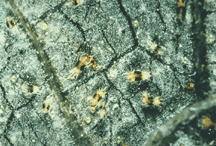
Aack! Spider mites!
And what to do if you've been invaded
By Marion Owen, Fearless Weeder
for PlanTea, Inc. and
Co-author of Chicken Soup for the Gardener's Soul
FEATURE ARTICLE:

Tom Hanks' "Power of Four" solution
More good stuff:
Who is Marion Owen?
FAQs about PlanTea
Search Marion's articles, tips and recipes
Why grow organic?
News and press releases
Read love letters
How to link to this site
Need a speaker?
How to contact Marion
Visiting Alaska?
Come to Kodiak Island!
Go to home page

Marion's UpBeet Gardener
Newsletter has been
replaced by Marion's blog
which you can find at:
www.marionowen.wordpress.com
The other day, I received an email 'plea for help' from Donna Blair, in Philadelphia, Pennsylvania:
Dear Marion, I purchased an ivy plant about four months ago. It was growing beautifully, until recently when I noticed that the leaves weren’t as green as they normally were and it now looks as if little spiders are everywhere on the leaves and stems and they’re on what looks like a web, but not exactly...It’s silky looking. Are they baby spiders?
 I
slumped in my chair, feeling like a doctor about to relay bad news. What
I really wanted to say was, "No prob. Just brush the webs away." But I
would have been lying. Donna's beloved ivy was indeed infested with spider
mites, one of the most devastating things that can happen to an indoor
plant.
I
slumped in my chair, feeling like a doctor about to relay bad news. What
I really wanted to say was, "No prob. Just brush the webs away." But I
would have been lying. Donna's beloved ivy was indeed infested with spider
mites, one of the most devastating things that can happen to an indoor
plant.
Mites are not true insects. They're actually related to spiders and daddy longlegs. They're nearly impossible to see. In fact, they usually appear as no more than animated specks of dust the size of this period at the end of this sentence. The Vermont Extension Service photo at right shows them greatly enlarged.
Sorry to say, but spider mites are not only hard to see, they're nearly impossible to get rid of. If you suspect an infestation, signaled by stippled, mottled, curled or distorted plant leaves, which is caused by the mites' piercing mouth parts, quarantine your plant immediately so its neighbors don’t become infested.
 Then,
dip or spray the plant with insecticidal soap. Misting your plants with
water also helps, since mites thrive in a warm and dry atmosphere--Hello!
Like what you'd find in most homes and office buildings. Another thing,
mites can be spread easily on your hands and clothing (they even blow
around with puffs of air).
Then,
dip or spray the plant with insecticidal soap. Misting your plants with
water also helps, since mites thrive in a warm and dry atmosphere--Hello!
Like what you'd find in most homes and office buildings. Another thing,
mites can be spread easily on your hands and clothing (they even blow
around with puffs of air).
If you've tried everything--and I rarely suggest this--you may need to send the plant to the great compost pile in the sky.
Wait! There's more to this lesson...
Donna’s experience brings up three very important points:
- Check your houseplants often for pests and diseases.
- Be sure to isolate new plants for a few weeks after you bring them
home. Reason: They might be bringing unwanted guests with them. (Remember
the story of the Trojan Horse?)
- When it comes to spider mites, prevention is far easier than the cure.
Thanks for visiting. Keep your hands in the dirt, and your dreams on a star.
-- Marion Owen
![]()
Thanks for visiting and please stop by again. I'll put the coffee on!
Meet Marion Owen /// Learn about PlanTea /// Online Catalog /// Articles, Tips, Recipes /// Get free UpBeet Gardener newsletter /// Read current issue /// Listen to radio show /// Read news and press releases /// More resources and links /// Learn why 'grow organic?' /// View guidelines for retailers /// Read love letters /// Book Marion as a speaker /// Site map /// How to link to us /// Contact us /// Go to home page
PlanTea: The organic plant food in tea bags. http://www.plantea.com
Copyright ©1996 to present: PlanTea, Inc. All Rights Reserved. PO Box 1980, Kodiak, AK 99615-1980 USA
Questions or comments? marion@plantea.com Phone: Toll Free: 1-800-253-6331 (US and Canada); 907-486-2500